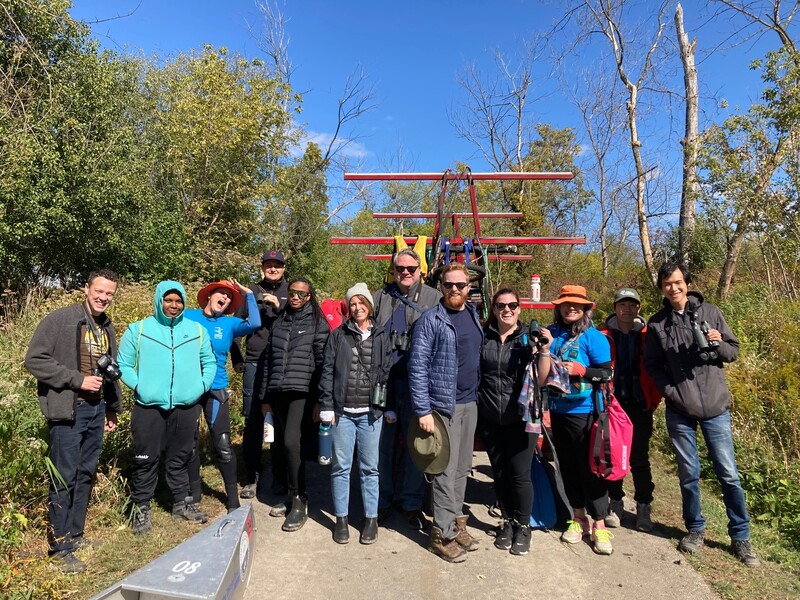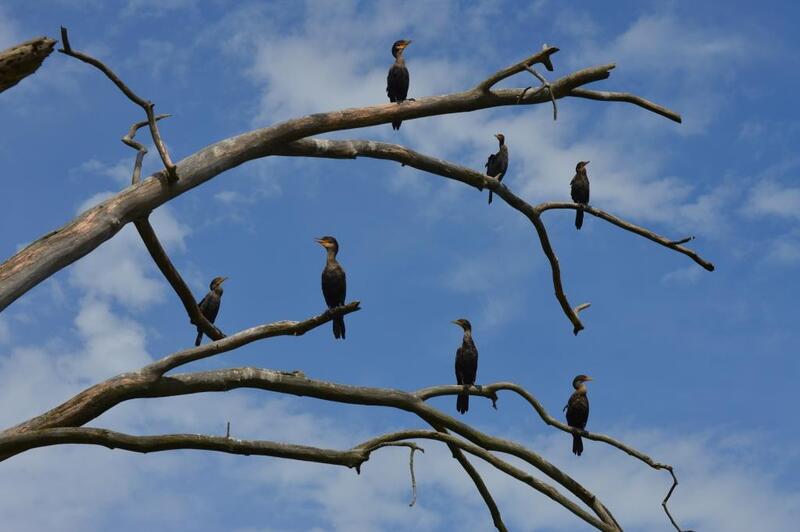World Migratory Bird Day Paddle was Informative and Inspirational!
The Chicago-Calumet River system is a critical flyway for migratory birds, but what does that really look like? How many birds are we talking about? What kinds of birds? Friends teamed up with the Chicago Ornithological Society (COS) on October 8, World Migratory Bird Day, to find out and to create a snapshot of just what kinds of birds are using the river system for habitat.
Chicago Ornithological Society (COS) President Edward Warden dreamed up this event because, "Observing migration and paddling on the Chicago River are some of the most fun and unique outdoor activities for this time of year. So why not enjoy both at once! COS is very happy to be able to team up with Friends and ensure people of any experience level can enjoy Chicago's wild side." We piloted this trip in May to great success, hence the fall trip. Check out the blog on that trip here.
It was a beautiful day.

Kickapoo Woods group
On a bright October morning with the trees in full fall foliage, sun shining, beautiful blue skies with just the occasional puffy cloud, it was a perfect day for 50 friends to set off on a joyful adventure – with a little citizen scientist thrown in –to search for birds from the vantage point of the river. With the training, assistance and encouragement of Friends’ volunteer canoe guides, beginning and experienced birders were prepared to paddle from River Park in Chicago’s Albany Park neighborhood, and at Kickapoo Woods in south suburban Riverdale. Our partners at the Chicago Ornithological Society (COS) added the avian expertise to facilitate spotting, tracking and of course, a little friendly competition between the two locations. Warden led the group at River Park, while fellow COS birders Jake Vinsel and Bob Dolgan joined the Kickapoo Woods group.
Annette Anderson, Friends’ volunteer, events, and canoe program manager said, “With no real destination or distance to travel, we were able to take our time, floating down the river, peering through binoculars, pointing out our finds, some birds easy to identify, others needing a few pairs of eyes to help discern those tiny differences on some of the tiniest birds.” Mallards casually watched from the banks, Double-crested Cormorants gracefully perched in dead trees, and the occasional Great Blue Heron flew overhead, which were some of the easier birds to spot, others were more of a challenge. Anderson noted, “What many of us learned was how to open our ears, hearing Belted Kingfishers with their distinct chattery-chirps, a Downy Woodpecker working away in the distance and the screech of a Red-tailed Hawk, all so distinct and with their specific reason.”
Double-crested Cormorants
Following the paddle our COS experts compared e-bird notes, finding it funny one group only saw a few Kinglets, while the other saw over 100. When asked what most surprised him, Edward said, “The Wilson's Snipe surprised me the most and was probably our best bird by birder standards. It's not exactly a rare bird, but uncommon on the Chicago River and unusual to be seen sitting out in the open and even more unusual that the entire group got to see it.”

Wilson's Snipe
The Results
All in all, both groups combined to see 51 different species and 770 individual birds under three hours. Both groups saw 22 of the same species of birds. The group at River Park saw 10 unique birds the group at Kickapoo didn’t see (including getting the heron hat-trick of seeing all three herons), while the group at Kickapoo saw 19 birds the River Park group didn’t see. We’ve included an aggregated list below, sorting out birds unique to each location. The full lists for each location are available here.
What amazing and frankly staggering data!
To put our data in perspective, the Chicago-Calumet river system is part of the Mississippi River Basin, which according to Audubon (https://www.audubon.org/mississippi-flyway), is used by 325 bird species for migration (meaning we saw about 1/6th of all mirgating species on our adventure). Looking at a live tracking map (see image) from BirdCast (https://birdcast.info/migration-tools/live-migration-maps), at midnight on October 8, 650 million birds were migrating through the U.S. On other days, September 11 for example, you can see the Illinois River, the Chicago and Calumet Rivers and Chicago lit up in bright yellow illustrating their importance to migratory birds.
Reading this data is a little mind-boggling. Seeing the birds in person is an experience we won’t soon forget. It provided a truly personal understanding of the importance of the river system and inspiration to care for this critical habitat. At times, it even seemed like the birds were in on our goal to document birds throughout the river system. The group at Kickapoo was greeted by a Great Egret perched on a rock in the middle of the river, just upstream from our boat launch, as if it was ushering us on our adventure and encouraging our exploration (our Instagram for the video). When we returned to the launch, four Sandhill Cranes flew overhead far, far up in the sky, but distinct none the less, waving us farewell till next year.

Sandhill Cranes
Birds seen at both River Park and Kickapoo Woods:
- Canada Goose: 28
- Mallard: 149
- Rock Pigeon (Feral Pigeon): 37
- Mourning Dove: 9
- Chimney Swift: 12
- Ring-billed Gull: 2
- Double-crested Cormorant: 8
- Great Blue Heron: 6
- Red-tailed Hawk: 3
- Belted Kingfisher: 6
- Downy Woodpecker: 12
- Blue Jay: 7
- Golden-crowned Kinglet: 71
- European Starling: 47
- American Robin: 67
- House Sparrow: 27
- American Goldfinch: 98
- White-throated Sparrow: 13
- White-crowned Sparrow: 2
- Song Sparrow: 3
- Yellow-rumped Warbler: 43
- Northern Cardinal: 10
Birds seen only at River Park:
- Hooded Merganser: 1
- Wilson's Snipe: 1
- Cooper's Hawk: 2
- Green Heron: 1
- Black-crowned Night-Heron: 1
- Black-capped Chickadee: 7
- Ruby-crowned Kinglet: 2
- Common Yellowthroat: 1
- Eastern Phoebe: 1
- Swainson's Thrush: 1
Birds seen only at Kickapoo Woods:
- Wood Duck: 12
- Sandhill Crane: 4
- Killdeer: 7
- Great Egret: 5
- Turkey Vulture: 5
- Red-bellied Woodpecker: 2
- Hairy Woodpecker:1
- Northern Flicker: 5
- White-breasted Nuthatch: 1
- Brown Creeper: 1
- Cedar Waxwing: 12
- House Finch: 1
- American Tree Sparrow: 2
- Swamp Sparrow: 2
- Brown-headed Cowbird: 1
- European Starling: 10
- Northern Waterthrush: 1
- Tennessee Warbler: 1
- Palm Warbler: 2
Pictures in the sliding header above:
- Kickapoo guests on the water - FOCR staff photo
- Belted Kingfisher - public domain
- Red-tailed Hawk - public domain
- Golden-crowned Kinglet - public domain
- Great Blue Heron - public domain
- Green Heron - Photo taken on the North Shore Channel in 2020 by Matt Greenberger
- Wilson's Snipe - public domain










